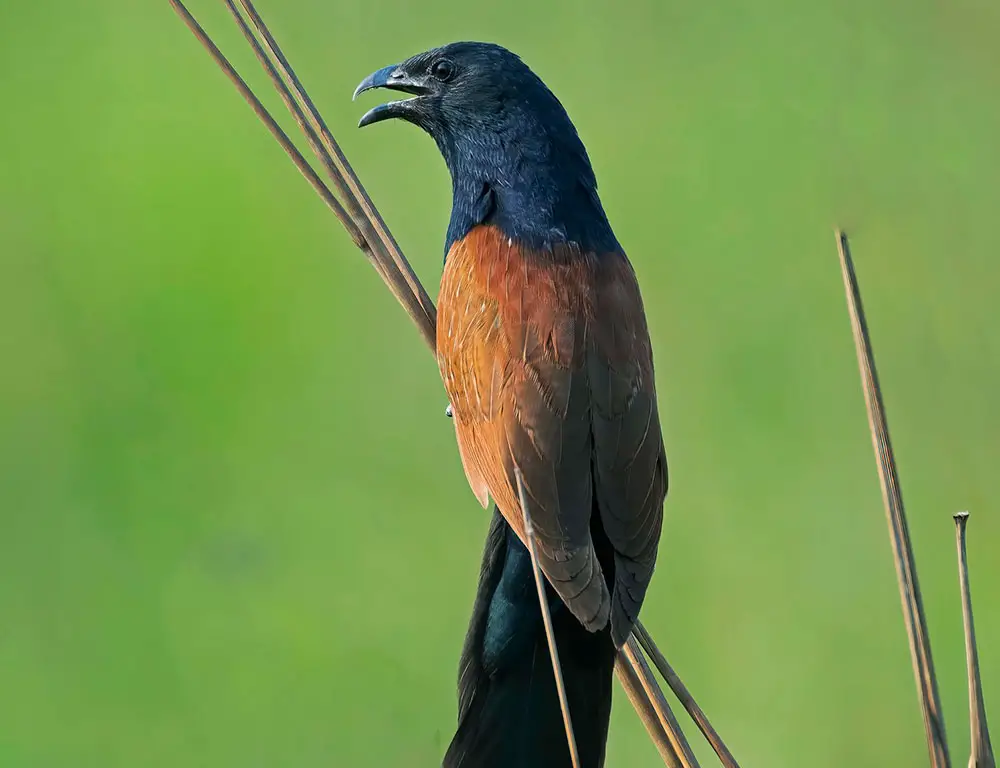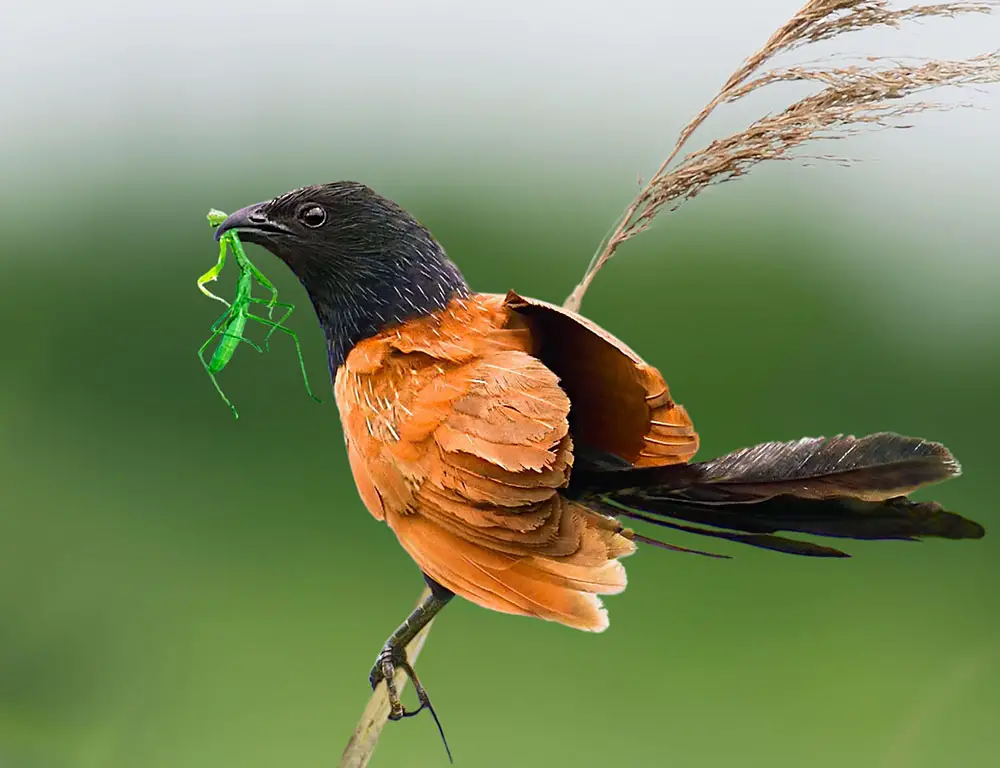The Lesser Coucal, a bird often overshadowed by its larger cousin, the Greater Coucal, possesses its allure and mystique. Native to the lush landscapes of South Asia and Southeast Asia, this elusive creature captivates with its unique characteristics and behaviors.
Often mistaken for its larger relative, the Lesser Coucal subtly differs in size and coloration, boasting rich chestnut wings contrasting beautifully against its black body.
While typically found in dense vegetation and grasslands, it showcases remarkable adaptability to various environments, including secondary growth and cultivated lands.
Despite its commonness, its shy demeanor often keeps it hidden from casual observation, adding to its enigmatic charm. Join us as we embark on a journey to uncover the lesser-known facts about this intriguing species, delving deeper into the world of the Lesser Coucal.

Physical Characteristics of the Lesser Coucal
The Lesser Coucal (Centropus bengalensis) possesses distinctive physical characteristics that set it apart within the avian world. Here’s a detailed look at its physical traits:
Size
The Lesser Coucal is a relatively large bird, measuring around 34-39 centimeters (13.4-15.3 inches) in length from beak to tail.
Shape
It has a robust body with a broad chest and shoulders, giving it a solid appearance. Its wings are wide and rounded, while its tail is long and often held upward when perched.
Coloration
- Body: The plumage of the Lesser Coucal is predominantly glossy black, giving it a striking appearance. The black coloration is often iridescent under sunlight.
- Head and Neck: The head and neck of the bird are also black, blending seamlessly with the rest of its body.
- Wings: During flight or when the wings are spread, chestnut-brown wing patches become visible. These patches contrast with the black plumage and add visual interest to the bird’s appearance.
- Eyes: The Lesser Coucal has bright red eyes, which stand out prominently against its dark feathers.
- Legs and Feet: Its legs are stout and robust, well-adapted for perching and walking on the ground. The feet are equipped with sharp claws for grasping branches and prey.
Bill
The bill of the Lesser Coucal is relatively long, strong, and slightly curved downwards. It is well-suited for capturing and consuming a variety of prey, including insects, small reptiles, and amphibians.
Sexual Dimorphism
Regarding sexual dimorphism, male and female Lesser Coucals generally have similar appearances, making it difficult to distinguish between the sexes based on physical characteristics alone.
However, slight differences in size or plumage coloration may sometimes exist between males and females.
Habitat and Distribution of the Lesser Coucal

The habitat and distribution of the Lesser Coucal (Centropus bengalensis) are closely tied to its ecological preferences and geographic range.
Here’s an overview of where you can typically find this species:
Habitat
The Lesser Coucal (Centropus bengalensis) primarily inhabits a variety of dense vegetation habitats across its range in South and Southeast Asia.
Here are the main types of habitats where you can find the Lesser Coucal:
- Tall Grasslands: Lesser Coucals are often found in areas with tall grasses, where they can seek cover and hunt for prey. These habitats include grasslands, meadows, savannas, and marshlands.
- Scrublands: They also inhabit scrubby areas with dense vegetation, such as shrublands, thickets, and brushy clearings.
- Rice Fields and Agricultural Lands: In regions where rice cultivation is common, Lesser Coucals may be found in rice fields and other agricultural landscapes, where they forage for insects and other small prey.
- Secondary Growth: They are known to adapt to disturbed habitats with secondary growth, including regenerating forests, degraded areas, and human-altered landscapes.
- Wetlands: Marshes, swamps, and wetland edges are favored habitats for Lesser Coucals, where they can find both prey and suitable nesting sites.
- Suburban Gardens: Sometimes, Lesser Coucals may venture into suburban areas with suitable vegetation cover, including gardens, parks, and green spaces.
Distribution
The Lesser Coucal is native to South and Southeast Asia, with a relatively broad distribution across several countries. Its range extends from the Indian subcontinent to Southeast Asian archipelagos.
Here are some key regions where the species can be found:
- South Asia: Lesser Coucals are commonly found in India, Bangladesh, Nepal, Bhutan, and Sri Lanka. They inhabit various regional habitats, from grasslands to wetlands and agricultural areas.
- Southeast Asia: In Southeast Asia, the species occurs in Myanmar, Thailand, Laos, Cambodia, Vietnam, Malaysia, Indonesia, and the Philippines. Its distribution may vary within these countries based on local habitat conditions and environmental factors.
- Islands: Lesser Coucals are also on numerous islands within their range, including those in the Indonesian archipelago, the Philippines, and other island groups.
Behavior and Diet of the Lesser Coucal

The behavior and diet of the Lesser Coucal contribute to its fascinating role in the avian world. Here’s an overview of its behavior and feeding habits:
Behavior
The behavior of the Lesser Coucal encompasses a range of activities related to its daily life, including vocalizations, foraging, breeding, and interactions with its environment.
Here’s an overview of the behavior exhibited by this species:
Vocalizations
The Lesser Coucal has a distinctive call described as a series of low ‘coop-coop-coops’, often repeated two or three times in quick succession.
This vocalization serves as a means of communication and can be heard particularly during dawn and dusk when the bird is most active.
Habitat and Movement
Lesser Coucals are typically found in areas with tall grasses, such as rice fields, sugarcane plantations, marshlands, and suburban gardens. They have a knack for staying hidden in these environments, making them somewhat elusive.
Despite their terrestrial habits, they are also agile flyers.
Breeding and Nesting
Unlike many other cuckoos, Lesser Coucals are not brood parasites; they build their nests. Breeding season usually falls between April through September, and they typically lay two to five eggs per clutch.
Diet
The Lesser Coucal is an omnivorous bird with a varied diet with many prey items.
Here’s an overview of the diet of the Lesser Coucal:
Insectivorous Diet
The primary diet of the Lesser Coucal consists largely of insects, with caterpillars being one of their favorite prey items. They have been observed stalking their prey on the ground before pouncing with precision, showcasing their hunting skills.
Omnivorous Nature
While insects form the bulk of their diet, Lesser Coucals are not picky eaters and will consume small reptiles and amphibians when given the opportunity. This omnivorous diet reflects their adaptability to various environmental conditions.
Conservation Status of the Lesser Coucal

The conservation status of the Lesser Coucal (Centropus bengalensis) is currently assessed as “Least Concern” by the International Union for Conservation of Nature (IUCN).
Here’s an overview of its conservation status and some factors influencing it:
Least Concern Status
The designation of “Least Concern” indicates that the species is not currently facing a significant risk of extinction. The Lesser Coucal population is considered relatively stable and does not meet the criteria for being classified as threatened or endangered.
Wide Distribution
The Lesser Coucal has a broad distribution range across South and Southeast Asia. It inhabits various habitats, including grasslands, wetlands, agricultural areas, and secondary-growth forests.
Its ability to adapt to diverse habitats contributes to its widespread distribution.
Population Trends
While specific population data for the Lesser Coucal may be limited, overall population trends are considered stable. The species is not subject to significant population declines or other threats that would warrant a higher conservation status.
Habitat Loss
Despite its current status, habitat loss and degradation remain potential threats to the Lesser Coucal.
Human activities such as deforestation, conversion of natural habitats for agriculture or urban development, and habitat fragmentation can impact the availability of suitable habitats for the species.
Climate Change
Climate change may also indirectly threaten the Lesser Coucal and its habitat.
Changes in temperature, precipitation patterns, and other environmental factors could alter habitat suitability and affect the distribution and abundance of prey species upon which the coucal depends.
Conservation Efforts
While the Lesser Coucal is not the target of specific conservation initiatives, efforts to protect and conserve its habitats indirectly benefit the species.
Conservation measures aimed at preserving natural habitats, promoting sustainable land use practices, and mitigating the impacts of habitat loss and degradation are essential for ensuring the species’ long-term survival.
FAQs
What is the lifespan of a Lesser Coucal in the wild?
The lifespan of a Lesser Coucal in the wild is estimated to be around 5-7 years, though this can vary depending on factors such as predation, disease, and habitat quality.
Does the Lesser Coucal migrate seasonally?
While some individuals may undertake seasonal movements in response to changes in food availability or environmental conditions, the Lesser Coucal is generally considered a non-migratory species.
What role does the Lesser Coucal play in its ecosystem?
As an omnivorous bird, the Lesser Coucal controls insect populations and may contribute to seed dispersal through its feeding habits and movement within its habitat.
How does the Lesser Coucal build its nest?
The Lesser Coucal constructs its nest using various plant materials, such as twigs, leaves, and grasses. The nest is typically placed low in dense vegetation or shrubs, providing camouflage and protection for the eggs and chicks.
What predators are known to prey on the Lesser Coucal?
Common predators of the Lesser Coucal include birds of prey such as hawks and owls and terrestrial predators like snakes and mammals such as cats and mongooses.
Conclusion
Delving into the world of the Lesser Coucal has been a richly rewarding journey. Its captivating black plumage, melodic calls, and diverse habitats showcase nature’s ingenuity.
Through understanding its distinct identity, behavioral patterns, and adaptability across varied environments, we appreciate its role in our planet’s ecological balance.
While not currently endangered, the species faces threats from habitat destruction, emphasizing our responsibility to preserve biodiversity.
Let’s commit to respecting and protecting all creatures, ensuring future generations can continue marveling at nature’s splendor.
Exploring the life of the Lesser Coucal has been enlightening, and I hope it sparks a similar appreciation for others.